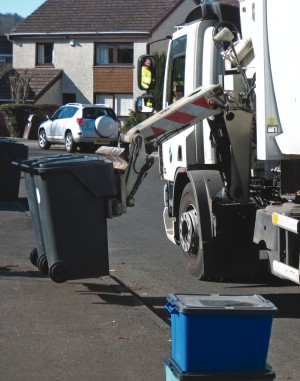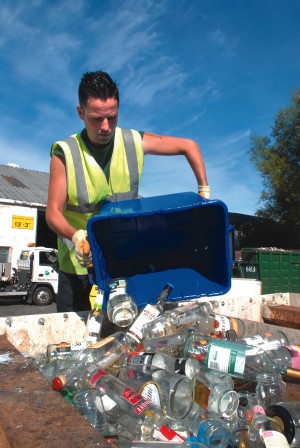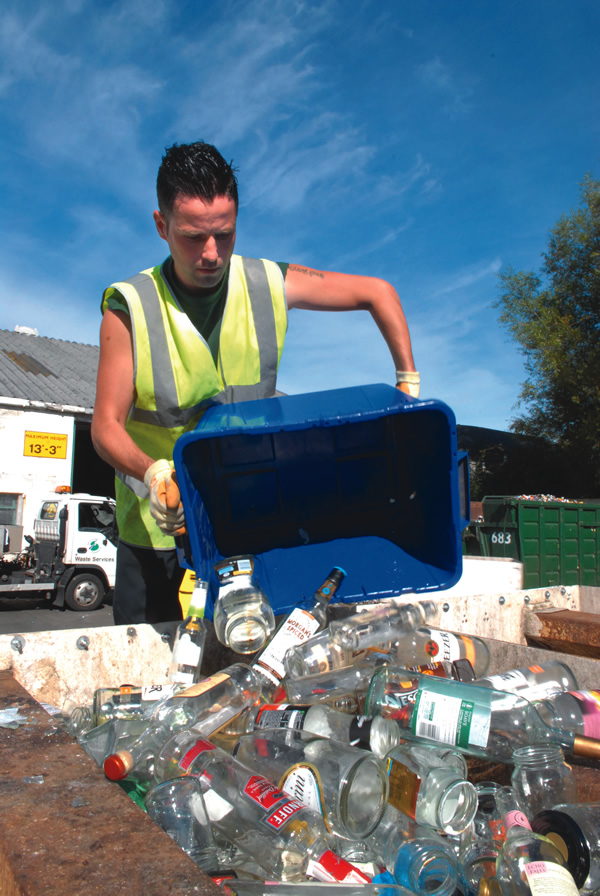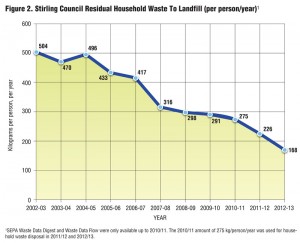In the United Kingdom, 299 out of 406 local authorities have introduced alternate weekly collection of household refuse. Many combine it with weekly collection of food waste.
David Riggle
BioCycle July 2013, Vol. 54, No. 7, p. 52

Grey bins for materials that can’t be recycled are emptied every other week in Stirling Council. Food waste is collected weekly.
That’s not the only collection service they provide, of course. The entire scope of what materials must be collected and how that is best accomplished has introduced a number of locally appropriate variations on an AWC theme. “Generally,” as the Alternate Weekly Collection Guidance report (WRAP, 2007) from the Waste & Resources Action Programme (WRAP) points out, “the residual waste is collected one week and the recyclable fraction is collected the next.”
What’s behind this major shift in waste collection practice? As with most recent household recycling and waste innovations and improvements in the UK, if you peel back the local, regional and national layers, the 1999 European Landfill Directive soon comes into view. With its specific requirement of all member states (the United Kingdom being one) to: “…prevent or reduce as far as possible negative effects on the environment from the landfilling of waste,” it caused significant ripples across Europe as countries and regions determined how they would meet these new obligations. England, Wales, Northern Ireland and Scotland each developed their own similar response.
As expected, there was much debate and consultation over the best way(s) forward. The waste hierarchy was popularized with waste prevention at the top as the most desirable option and disposal at the bottom as a very last resort. Much of the onus to deliver new and better ways of dealing with waste fell to local government, which, in the UK, is required by law to collect (or ensure collection) of waste from households. Local Authorities were often teamed up with adjoining authorities and charged with developing a workable plan for keeping waste out of landfill that would have both public and political backing.
Early on in the analysis of options for compliance with the directive, AWC was put forward as a viable alternative. In Scotland, for example, a study on separate waste collection systems was commissioned to evaluate options (Scottish Executive, 2003). In the AWC example, households would have three wheeled bins, one each for dry recyclables, biodegradable waste and residuals. It was suggested that the scheme could aim for a 3-week rotation of collection for each stream, “but may wish to start with fortnightly uplifts of residuals and uplifts of dry recyclables and biodegradable waste every four weeks on alternate fortnights.” Looking back on this study now, it seems very basic, but at the time it provided the encouragement and support needed for councils to put forward and debate different collection options in the face of traditionally entrenched local politics, public perceptions or operational considerations.
Stirling Scenario
Located almost midway between Glasgow and Edinburgh, Stirling Council sits just between the highlands and lowlands of Scotland, encompassing a bit of both in its 848 square miles. It’s home to around 91,000 people (40,000 households) mostly concentrated in the southeast of the district around the City of Stirling (pop. 41,000). Smaller towns and villages are spread across the Council’s extensive northern and western rural area.
Ten years ago, Stirling Council’s official recycling and composting rate was just 6.5 percent; about 500 kg (1,100 lbs)/person/year were being sent to landfill (Figure 2). For 2012/13 the household recycling/composting rate was 55.4 percent and the residual waste to landfill amount fell to 168 kg (370 lbs)/person/year. Achieving such a radical improvement in one decade included changing the long established collection frequency for residual waste in the towns and villages. “Switching to an alternate weekly collection system really helped people understand that we were required to move things in a new and much more sustainable direction,” says David Hopper, Waste Services Manager at Stirling Council and chief architect of the Council’s solid waste management plan.
The proposed new collection system in Stirling was piloted by around 6,000 homes starting in May 2003. It was soon an operational success, as well as a success in reducing the amount of waste going to landfill. Feedback from the public was varied, although mostly positive. A few minor operational adjustments were made after evaluation, following which the new collection system was approved by the Council in September 2003. It was then rolled out across the area to all eligible homes over the next few months.
Changing The Status Quo
While that sounds nice and clear-cut when summarized in a paragraph or two, the actual process of implementing and enforcing a new collection system in Stirling was a bit more complex. To understand, it is necessary to look back in time before the Landfill Directive was a European policy maker’s dream. In the 1990s, the Council distributed 63-gallon green bins with wheels (known as “wheelie bins”) for trash collection throughout the area and emptied them weekly. By 2001-02, 90 percent of the Council’s 37,000 households had one — or more than one, as it turned out. Unfortunately, from a future recycler’s standpoint, no limit was set on the number of these new bins to which each household was entitled. In waste management terms of the time, “containment” of waste was seen as a big improvement and “waste reduction” hadn’t really entered the vocabulary yet.
Additionally, it wasn’t uncommon for Local Authorities to own one or more landfills. In the days when the government’s Landfill Tax was only $11/metric ton, disposal costs were very low and the incentive to limit the number of wheelie bins per household just wasn’t there. (Currently the Landfill Tax is $110/metric ton and due to rise to $123 in April 2014 (this is in addition to the per ton tipping fee)). Roadside recycling dropoff containers were dotted around if households desired to use them. This approach, in one degree or another, was typical of waste management behavior across the country, which of course is why the recycling/ composting rate was only 6.5 percent in the Stirling Council area, 8 percent for Scotland as a whole, and not much better for the rest of the UK.
The pilot collection system rolled out in Stirling in 2003 gave households 3 containers instead of one; weekly collection was still provided but only for glass, cans, paper, plastic bottles and textiles in a 15-gallon recycling box. Additionally, one week a brown 63-gallon bin for garden waste and cardboard was emptied, and the following week a grey 63-gallon bin for household refuse destined for landfill was picked up. Households could have as many recycling boxes as they could feasibly use and two brown bins, but only one grey bin. The pilot amply demonstrated that families up to six members would have enough room in the grey bin to last two weeks, if they fully utilized the new recycling box and brown bin. However, if they didn’t, the grey bin might fill up before it was due to be emptied.
This situation was one of the greatest challenges, as well as perhaps the greatest advantage of introducing AWC for household waste in Stirling: people were required to change what had become an ingrained disposal habit. The Council, which fortunately had the political will to firmly move towards recycling, set a policy that explicitly allowed a household of five full time residents or less to have only one 63-gallon grey bin. Families of six or more could apply for a larger 95-gallon bin, but it still would only be emptied every other week. If a household produced more nonrecyclable waste than would fit in the bin, someone would have to take it to a drop off area at the landfill, referred to as the “Tip.” In a stroke of good fortune, at least in terms of locally promoting the need to recycle, Stirling Council’s 20-year-old landfill closed in 2004. Additionally, funding was obtained that allowed the Tip to be redesigned and transformed into a Household Waste Recycling Centre, where the emphasis likewise shifted from disposal to reuse and recycling.
”We worked very hard to get across the message that a family’s waste doesn’t belong to the Council,” says Hopper. “It’s the householder’s waste. They produced it. We have a responsibility to take it away and recycle as much of it as possible, and we will help people understand how best to help us do that, but it would be better if everyone learned not to produce waste in the first place.”

Recyclables set out for curbside collection are segregated into multiple streams in Stirling Council, including clear glass. Photo courtesy of Stirling Council Waste Services
“We calculated the amount of residual waste per person being sent to landfill over the last decade,” says Hopper, “and the drop is quite apparent [see Figure 2]. That can be attributed to our collection system, the political support we had to implement it and the participation of householders. However, our goal is Zero Waste to landfill and we can’t be complacent about the distance we still have to go to get there.”
Dispelling Negative Perceptions
Stirling Council is just one example of an alternate weekly collection system that’s working very well. As noted earlier, Jennie Rogers has seen AWC schemes develop in England and across the UK from the start. She began collecting data on local authority waste and recycling operations for private clients in 1998 and in the process established good contacts with LAs across the country. There wasn’t much information available about what others were doing and Rogers started sharing what she learned. She launched “AskJennie,” a restricted access website for LAs in 2004 and has been adding to it ever since. In addition to AWC systems, she gathers information on, for instance, the type, color and size of containers used by LAs and processing and reprocessing contracts for recyclables.
“There’s a common perception that AWC for refuse leads to in increase in vermin or health problems, but it’s only a perception,” notes Rogers. “There is no health risk. AWC has been successfully operating in the UK for years now and it’s just not been proven to be the case.” She refers to a 2009 literature review jointly funded by WRAP and the Chartered Institution of Wastes Management (WRAP & CIWM, 2009). It focused on the potential health effects of fortnightly residual waste collection, examining over 150 published papers and documents in the process. “..No documented evidence of a direct link between the frequency of waste collection and any actual health impacts on householders or waste collectors was found…”
Rogers adds that others, like Wycombe District Council, have commissioned their own assessments of AWC over the years and concluded, in Wycombe’s case, “… that no significant adverse health effects are likely to be caused by alternate week waste collections of residual and biodegradable waste. Provided common-sense steps … are taken, any annoyance issues (e.g. odors or flies) can also be controlled” (Enviros Consulting, 2007). Common sense good practice measures include keeping waste containers closed to keep out flies or rodents, placing containers outdoors and out of direct sunlight, if possible, and washing hands, work surfaces and the containers themselves after contact with waste — especially food waste. Collectors, either the LAs themselves or their contractors, are reminded to have some flexibility in the types of containers supplied to different types of properties, to ensure householders clearly understand what is expected of them, to effectively handle and analyze complaints and make regular risk assessments of health and safety issues for waste collectors.
Almost all local authorities anecdotally report that AWC increases the amount of material being recycled, as well as participation in recycling schemes, notes Rogers. “It encourages the non-keen recycler to recycle, because they won’t have enough room in their refuse bin if they don’t. In the main, when local authorities introduce alternate weekly refuse, they also free up vehicles or money so that they can add additional recyclables to their collections. So residents get the benefit of the additional materials being removed from their refuse bin for recycling. At the start, sometimes there’s an issue with perception, because it’s a different system, but they generally love it once they get used to it.”
As a number of Councils, including Stirling have discovered, weekly collection of food waste removes most other objections to alternate weekly refuse that even the most skeptical person might have. Putrescible materials are kept out of the refuse bin and taken away every week. This does not include diapers and pet waste, which are set out biweekly with the trash. “Weekly food waste collection has usually come after fortnightly refuse,” explains Rogers. “These days, with some authorities, it’s not so much keeping residents happy by giving them food waste collection as it is getting more biodegradable wastes out of the landfill. With current landfill prices, it makes more economic sense to collect food waste, even though it is expensive. And with legislation like the Waste (Scotland) Regulations 2012 banning food waste to landfill by 2020 for northern parts of the UK, it’s a natural.”
Although food waste collection hasn’t always been introduced hand in hand with AWC, it is helping to make alternate weekly refuse collection more acceptable. “Basically,” concludes Rogers, “if you offer weekly food waste collection as well as AWC, then the residents have nothing to complain about.”
David Riggle is International Editor and a past Managing Editor of BioCycle. He has been living and working in Scotland for the past 14 years. He has been employed by the Waste Services department at Stirling Council since 2001, and before that coordinated development of a Local Agenda 21 Plan with community and environmental organizations in
Fife.












